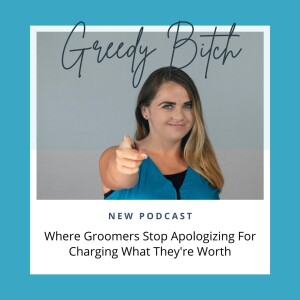
Should my pet grooming business pay employees commission?
 2023-06-09
2023-06-09
Intro:
Hello hello and welcome to Greedy Bitch, a podcast where groomers stop apologizing for charging their worth. I’m your host River Lee, founder of the Savvy Groomer.
Today's episode is sponsored by the Pay Masterclass, a 6-module masterclass where we teach you all about paying your employees legally.
Paying 50% is bull shit. We here at the Savvy Groomer have cracked the code of paying employees a liveable wage they’re happy with and creating sustainable profit for pet grooming business owners. Introducing the Pay Masterclass, a 6-module exploration on how to legally pay W2 employees, specifically designed for the pet grooming business. Busting myths while teaching you the skills and winning formulas you need to create a pay structure that actually works.
Let’s talk about today's topic:
Should my pet grooming business pay employees commission?
At the Savvy Groomer, we firmly believe that utilizing an hourly wage system coupled with production bonuses based on the Groomer Point System (GPS) is the most effective way to compensate our employees. This approach not only fosters a team mindset among our staff members but also ensures consistent and predictable payroll costs for our business. In this podcast, we will delve deeper into the reasons why we advocate for this payment structure.
When considering commission-based pay, it is essential to keep in mind certain legal stipulations. Commission-only employees are compensated based on the revenue they generate for the business. It is crucial to cap commission at a reasonable level, generally not exceeding 30%, in order to maintain a sustainable payroll expense. Furthermore, businesses opting for commission-based pay must navigate various legal obligations. For instance, at least 75% of the gross sales must come from commission-only services, and the employee should earn at least 50% of their income through commission. This requirement should not be confused with a 50% commission rate. Additionally, the employee must earn at least 1.5 times the state or federal minimum wage, whichever is higher, and their working hours must be meticulously tracked. Complying with these legal requirements can be complex, and we provide comprehensive guidance on commission-based pay in Module One of our Employee Pay Masterclass.
On the other hand, an hourly wage system offers several advantages. Hourly employees are paid based on the actual hours they work, which fosters a team mindset and encourages collaboration among team members. Moreover, this payment structure ensures consistent and predictable payroll costs, providing employees with reliable and stable paychecks. By implementing an hourly wage system, businesses can achieve a win-win situation for both the company and its employees. Detailed insights into the benefits of hourly pay can be found in Module One of our Employee Pay Masterclass.
At the Savvy Groomer, we propose a hybrid payment model that combines the advantages of hourly pay with production bonuses based on our GPS. Production bonuses are additional monetary rewards that employees receive when they meet or exceed specific performance expectations. These bonuses go beyond regular pay or salary and serve as incentives to drive productivity and maintain high-quality work. This approach is an effective way to motivate employees and boost their performance. We provide in-depth guidance on production bonuses in Module Six of our Employee Pay Masterclass.
Now, let's delve into what the Groomer Point System entails. The GPS is a transformative tool for grooming businesses. We offer a comprehensive workshop on Pricing & Points that explores this system in detail. In essence, a point in our GPS represents one unit of effort, approximately equivalent to 30 minutes of work.
Determining an employee's expected amount of production points involves setting up employee roles and establishing three tiers within those roles. For instance, you can have Bather Tier A, Bather Tier B, and Bather Tier C. As an employee's skills and performance improve, their points expectation increases accordingly. Generally speaking, Bather Tier A would be our baby bather or a beginner. Bather Tier B would be intermediate, or our knowledgeable or finished groomer. Bather Tier C would be the people that exceed things. That could either be a pet stylist versus a regular groomer. That could also be a power groomer versus a regular production groomer. Module Three of our Employee Pay Masterclass offers an extensive exploration of this topic.
All in all, the Savvy Groomer advocates for an hourly wage system combined with production bonuses based on the Groomer Point System. This approach promotes a team mindset among employees, ensures consistent and predictable payroll costs, and motivates staff members to achieve high productivity and maintain quality work. By implementing this payment structure, grooming businesses can create a positive and rewarding work environment for their employees while maintaining financial stability.
Outro:
If you guys are interested in learning more about the Pay Masterclass, be sure to visit me at savvygroomer.com/pgmc. This is a 6-module masterclass where we teach you how to pay your employees.
Thank you all so much for listening to this podcast, Should my pet grooming business pay employees commission?. Be sure to visit me at SavvyGroomer.com to see my current opportunities to work with me in growing your pet grooming business plus more free resources for you to learn. See you in our community on Facebook - Savvy Pet Professionals! As always, Happy Grooming
More Episodes
 2023-12-29
2023-12-29
 2023-12-22
2023-12-22
 2023-12-15
2023-12-15
 2023-12-08
2023-12-08
 2023-12-01
2023-12-01
 2023-11-24
2023-11-24
 2023-11-17
2023-11-17
 2023-11-10
2023-11-10
 2023-11-03
2023-11-03
 2023-10-27
2023-10-27
 2023-10-20
2023-10-20
 2023-10-13
2023-10-13
 2023-09-15
2023-09-15
 2023-09-08
2023-09-08
Create your
podcast in
minutes
- Full-featured podcast site
- Unlimited storage and bandwidth
- Comprehensive podcast stats
- Distribute to Apple Podcasts, Spotify, and more
- Make money with your podcast
It is Free
- Privacy Policy
- Cookie Policy
- Terms of Use
- Consent Preferences
- Copyright © 2015-2024 Podbean.com





